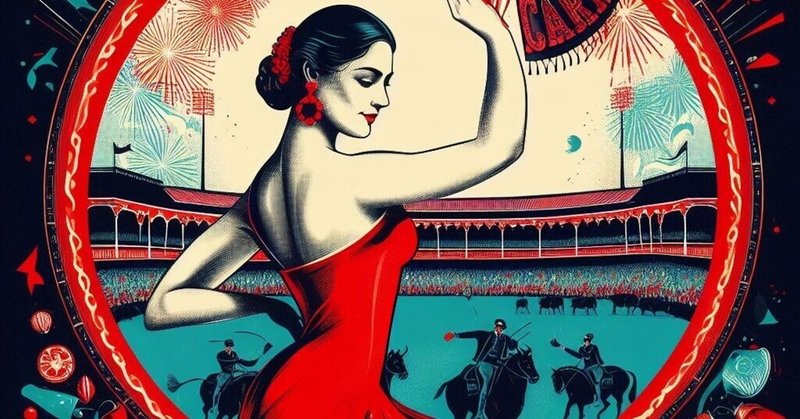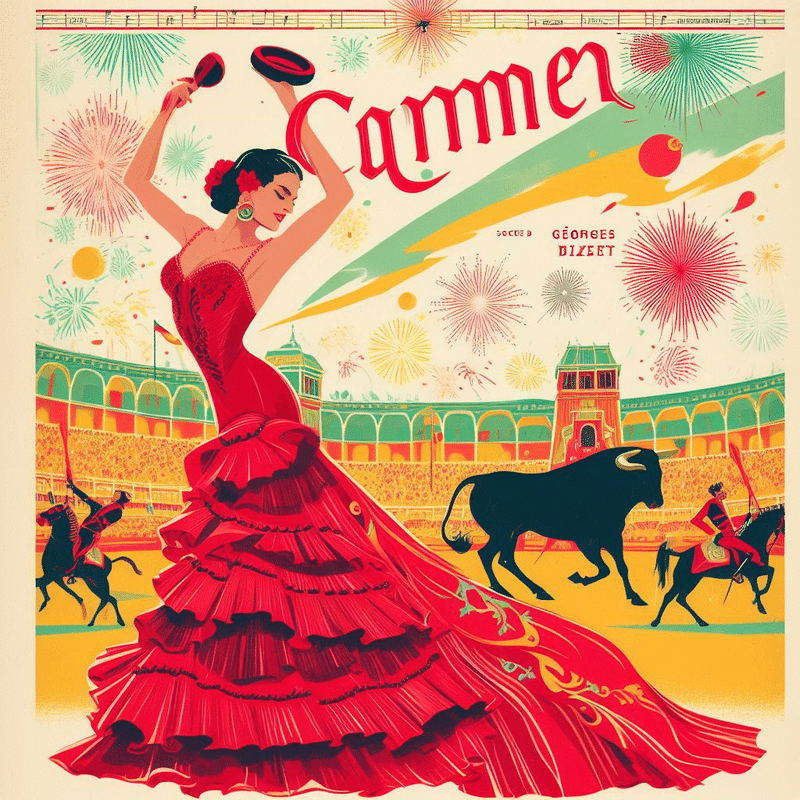
ビゼーの歌劇「カルメン」入門
オペラというと、難しそうに感じるかもしれませんが、実はとても面白くて感動的な芸術です。オペラは、音楽と演劇と美術が一体となった総合芸術と言われています。オペラには、様々な国や時代の作品がありますが、その中でも、特に人気が高く、よく上演されるのが、フランスの作曲家ジョルジュ・ビゼーが作曲した歌劇「カルメン」です。この記事では、この歌劇の魅力について、初心者の方にも分かりやすくご紹介します。
作曲家ビゼーと原作メリメ
ビゼーは、1838年にパリに生まれた作曲家です。音楽一家に育ち、10歳でパリ音楽院に入学しました。19歳でローマ大賞を受賞し、イタリアに留学しました。帰国後は、様々な音楽活動に従事しましたが、オペラ作曲家としての成功はなかなか得られませんでした。彼の最後のオペラである「カルメン」は、初演時に不評でしたが、彼の死後に大ヒットし、オペラ史上の名作となりました。ビゼーは、心臓疾患により36歳で亡くなりました。
「カルメン」の原作は、フランスの作家プロスペル・メリメの小説です。メリメは、1825年にパリに生まれた作家です。彼は、外務省に勤務しながら、小説や戯曲を書きました。彼の作品は、スペインや東洋などの異国の風俗や文化を描いたものが多く、ロマン主義の傾向が強いです。彼の代表作には、「カルメン」のほかに、「コロンバ」や「アルセーヌ・ギヨー」などがあります。
メリメの小説「カルメン」は、1845年に発表されました。この小説は、スペインのセビリアを舞台に、自由奔放なジプシー女カルメンと真面目な兵士ドン・ホセの悲劇的な恋の物語を描いています。メリメは、この小説を書くために、スペインを旅行し、現地の風俗や歴史を研究しました。この小説は、当時のフランス社会に衝撃を与え、多くの読者や批評家の反響を呼びました。
歌劇「カルメン」のあらすじと音楽
ビゼーは、メリメの小説「カルメン」をオペラにすることを決め、オペラ=コミック座のために作曲しました。オペラ=コミックとは、フランスのオペラの一種で、歌と台詞が交互に出てくるものです。ビゼーは、台本作家のアンリ・メイヤックとルドヴィック・アレヴィと協力して、原作の小説をオペラに適した形に改変しました。ビゼーは、このオペラの作曲に約2年を費やし、1875年に完成しました。
このオペラの初演は、1875年3月3日にパリのオペラ=コミック座で行われましたが、不評でした。観客や批評家は、このオペラの登場人物や音楽に衝撃を受けました。カルメンは、道徳に反する女性として描かれており、ドン・ホセは、愛に破滅する男として描かれていました。音楽も、スペイン風の旋律やリズムが多く用いられており、オペラ=コミックの伝統に反するものと感じられました。ビゼーは、このオペラの失敗に落胆し、同年6月に心臓発作で亡くなりました。
しかし、ビゼーの死後に、このオペラは再評価され、大ヒットしました。このオペラは、4幕形式のグランド・オペラ版と2幕形式のオペラ=コミック版があります。グランド・オペラ版は、台詞を歌に置き換えたもので、より壮大な効果を狙ったものです。オペラ=コミック版は、ビゼーのオリジナルに近いもので、より人間的な効果を狙ったものです。どちらの版も、それぞれの魅力があります。
このオペラのあらすじは、以下のようになっています。
• 第1幕: スペインのセビリアの広場。兵士のドン・ホセは、恋人のミカエラから手紙を受け取ります。そこに、タバコ工場の女工カルメンが現れ、男たちを惹きつけます。カルメンは、ホセに赤い花を投げつけて、彼に興味を示します。工場で喧嘩が起こり、カルメンは逮捕されます。ホセは、カルメンを見張る役目を任されますが、カルメンに誘惑されて、彼女を逃がしてしまいます。ホセは、カルメンの恋人になるために、軍を捨てて逃亡します。
• 第2幕: セビリアの酒場。カルメンは、ジプシーの仲間と一緒にいて、闘牛士のエスカミーリョに言い寄られます。カルメンは、エスカミーリョを拒絶し、ホセを待ちます。ホセが現れると、カルメンは彼と踊りますが、ホセは軍の笛の音を聞いて、戻ろうとします。カルメンは、ホセにジプシーの一味に加わるように誘いますが、ホセは断ります。カルメンは、ホセを見限りますが、ホセはカルメンを愛してやまないと言います。そこに、エスカミーリョが現れて、ホセと喧嘩になります。ホセは、エスカミーリョに刺し違えようとしますが、ジプシーたちに止められます。エスカミーリョは、ホセに対して闘牛場で決着をつけると言って去ります。カルメンも、ホセに別れを告げて、エスカミーリョについて行きます。ホセは、カルメンを引き留めようとしますが、ジプシーたちに阻まれます。ホセは、カルメンを失った悲しみと怒りに駆られて、泣き叫びます。
• 第3幕: ジプシーの一味の隠れ家。カルメンとホセは、ジプシーの一味に加わっていますが、仲は悪くなっています。カルメンは、ホセに飽きて、エスカミーリョに惹かれています。ホセは、カルメンに執着して、彼女を束縛しようとします。ジプシーの仲間は、カルメンに占いをしますが、カルメンは死の運命を告げられます。ミカエラが現れて、ホセに母親が病気だと伝えます。ホセは、カルメンに別れを告げて、ミカエラと一緒に去りますが、カルメンは冷たくあしらいます。エスカミーリョが現れて、カルメンに愛を告白します。カルメンは、エスカミーリョに応えますが、ホセの声が聞こえます。
• 第4幕: セビリアの闘牛場。カルメンとエスカミーリョは、闘牛場に向かいますが、ホセが現れて、カルメンに戻ってくるように懇願します。カルメンは、ホセを拒絶し、赤い花を投げ捨てます。ホセは、カルメンを殺してしまいます。闘牛場からは、エスカミーリョの勝利の声が聞こえます。ホセは、カルメンの死体に嘆きながら、自分の罪を告白します。
このオペラの音楽は、スペイン風の旋律やリズムが多く用いられており、情熱的で魅力的です。有名な「ハバネラ」や「闘牛士の歌」などの曲があります。私は、このオペラの音楽を聴くと、スペインの風景や文化を感じます。
歌劇「カルメン」の見どころとおすすめのYouTube
歌劇「カルメン」の見どころは、以下のようになっています。
• カルメンのキャラクター: カルメンは、自由奔放で魅力的な女性として描かれています。彼女は、男たちを惹きつけながらも、自分の気持ちに忠実に生きます。彼女は、愛にも死にも恐れない強い意志を持っています。彼女は、オペラの中で最も人気のあるヒロインの一人です。
• ドン・ホセのキャラクター: ドン・ホセは、真面目で忠実な兵士として描かれています。彼は、カルメンに恋をして、彼女のためにすべてを捨てます。しかし、カルメンに裏切られて、嫉妬と憎しみにとらわれます。彼は、愛に破滅する悲劇的なヒーローです。
• エスカミーリョのキャラクター: エスカミーリョは、勇敢で華やかな闘牛士として描かれています。彼は、カルメンに惚れて、彼女を自分のものにしようとします。彼は、カルメンと対照的に、生きることに喜びを見出す明るいキャラクターです。
• ミカエラのキャラクター: ミカエラは、純真で優しい村娘として描かれています。彼女は、ホセの恋人であり、母親の代わりになろうとします。彼女は、ホセをカルメンから救おうとしますが、失敗します。彼女は、カルメンと対照的に、死に対して恐怖を感じる普通のキャラクターです。
• 音楽の美しさ: このオペラの音楽は、スペイン風の旋律やリズムが多く用いられており、情熱的で魅力的です。有名な「ハバネラ」や「闘牛士の歌」などの曲があります。このオペラの音楽は、カルメンやドン・ホセの感情や運命を表現するのに優れています。
歌劇「カルメン」のおすすめのYouTube
• カラヤン指揮ウィーン・フィルハーモニー管弦楽団、ホセ・カレーラス(ドン・ホセ)、アグネス・バルツァ(カルメン)、ヨゼ・ヴァン・ダム(エスカミーリョ)、ジャネット・ペリー(ミカエラ): この録音は、4幕形式のグランド・オペラ版を使用しています。カラヤンの指揮は、音楽の重厚さやシンフォニックさを強調しています。ウィーン・フィルの演奏は、豪華で華麗です。カレーラスのドン・ホセは、情熱的で力強い歌唱です。バルツァのカルメンは、魅惑的で妖艶な歌唱です。ヴァン・ダムのエスカミーリョは、貫禄のある歌唱です。ペリーのミカエラは、清楚で可憐な歌唱です。
まとめ
歌劇「カルメン」は、ビゼーがメリメの小説を原作として作曲したオペラです。このオペラは、スペインのセビリアを舞台に、自由奔放な女性カルメンと真面目な兵士ドン・ホセの悲劇的な恋の物語を描きます。カルメンは、ドン・ホセに惹かれながらも、闘牛士のエスカミーリョに心変わりします。ドン・ホセは、カルメンのために軍を脱走し、ジプシーの一味に加わりますが、カルメンに捨てられます。最後に、ドン・ホセは、カルメンとエスカミーリョの仲を妬んで、カルメンを刺し殺します。このオペラは、カルメンの自由な精神とドン・ホセの狂気と悲哀を、情熱的な音楽と美しい歌で表現しています。

Introduction to Bizet's opera "Carmen"
Opera may seem difficult, but it is actually a very interesting and moving art form. Opera is said to be a comprehensive art that combines music, drama, and art. Opera includes works from various countries and eras, but one of the most popular and often performed is the opera ``Carmen'' composed by French composer Georges Bizet. In this article, we will introduce the appeal of this opera in an easy-to-understand manner, even for beginners.
Composer Bizet and original work Mérimée
Bizet was a composer born in Paris in 1838. He grew up in a musical family and entered the Paris Conservatory at the age of 10. At the age of 19, he won the Prix de Rome and went to study in Italy. After his return, he engaged in various musical activities, but his success as an opera composer was slow to come. His last opera, ``Carmen,'' was poorly received at its premiere, but became a huge hit after his death and became a masterpiece in opera history. Bizet died at the age of 36 due to heart disease.
"Carmen" is based on a novel by French author Prosper Mérimée. Mérimée was a writer born in Paris in 1825. He wrote novels and plays while working in the Foreign Office. Many of his works depict the customs and culture of foreign countries such as Spain and the Orient, and have a strong tendency toward romanticism. In addition to ``Carmen,'' his major works include ``Columba'' and ``Arsène Guillot.''
Mérimée's novel Carmen was published in 1845. This novel, set in Seville, Spain, depicts the tragic love story between Carmen, a free-spirited gypsy woman, and Don José, a serious soldier. To write this novel, Merime traveled to Spain and researched the local customs and history. This novel shocked French society at the time and resonated with many readers and critics.
Synopsis and music of the opera “Carmen”
Bizet decided to turn Mérimée's novel Carmen into an opera, and composed it for the Opéra-Comique. Opéra-comique is a type of French opera in which songs and dialogue alternate. Bizet worked with librettists Henri Meillac and Ludovic Halévy to adapt the original novel to suit the opera. Bizet spent about two years composing this opera, which was completed in 1875.
The opera was first performed at the Opéra-Comique in Paris on March 3, 1875, but was not well received. Audiences and critics were struck by the opera's characters and music. Carmen was portrayed as an immoral woman, and Don José was portrayed as a man destroyed by love. The music also used a lot of Spanish-style melodies and rhythms, which I felt went against the opera-comic tradition. Bizet was disappointed by the opera's failure and died of a heart attack in June of the same year.
However, after Bizet's death, the opera was reevaluated and became a huge hit. This opera is available in a four-act grand opera version and a two-act opera-comic version. The grand opera version replaces the dialogue with songs, aiming for a grander effect. The Opéra-Comique version is closer to Bizet's original and aims for a more human effect. Both versions have their own charms.
The synopsis of this opera is as follows.
• Act 1: Plaza de Seville, Spain. Don José, a soldier, receives a letter from his lover Micaela. Then Carmen, a female tobacco factory worker, appears and attracts her men. Carmen throws a red flower at Jose to show him her interest. A fight breaks out at the factory and Carmen is arrested. Jose is entrusted with the task of keeping an eye on his girlfriend Carmen, but he is seduced by Carmen and lets her escape. Jose deserts her army and runs away to become Carmen's lover.
• Act 2: Seville Tavern. Carmen is with a group of gypsies and is approached by Escamillo, a bullfighter. Carmen rejects Escamillo and waits for Jose. When Jose appears, Carmen dances with him, but Jose hears the sound of a military whistle and tries to return. Carmen invites Jose to join her gang, but Jose declines. Carmen gives up on Jose, but Jose says he still loves Carmen. Escamillo then appears and gets into a fight with Jose. Jose tries to stab Escamillo, but is stopped by the gypsies. Escamillo leaves, telling Jose that he will settle the matter in the bullring. Carmen also says goodbye to Jose and follows Escamillo. Jose tries to hold Carmen back, but is stopped by the gypsies. José cries out, overcome with sadness and anger over the loss of Carmen.
• Act 3: The gypsy gang's hideout. Carmen and Jose join a gang of gypsies, but they don't get along. Carmen is tired of Jose and is attracted to Escamillo. Jose is obsessed with his girlfriend Carmen and tries to restrain her. A fellow gypsy tells Carmen a fortune-telling, but Carmen is told of her fate. Michaela appears and tells Jose that her mother is sick with her. Jose says goodbye to Carmen and leaves with Micaela, but Carmen treats him coldly. Escamillo appears and confesses her love to Carmen. Carmen responds to Escamillo, but she hears Jose's voice.
• Act 4: Bullring in Seville. Carmen and Escamillo head to the bullring, but Jose appears and begs Carmen to come back. Carmen rejects Jose and throws away the red flower. Jose kills Carmen. Escamillo's victory can be heard coming from the bullring. As Jose mourns over Carmen's corpse, he confesses his sins.
The music of this opera is passionate and appealing, with many Spanish-style melodies and rhythms. There are songs such as the famous "Habanera" and "Song of the Bullfighter". When I listen to the music of this opera, I feel the landscape and culture of Spain.
Highlights of the opera “Carmen” and recommended YouTube
Highlights of the opera "Carmen" are as follows:
• Carmen's character: Carmen is portrayed as a free-spirited and attractive woman. She lives true to her feelings while attracting her men. She has a strong will and is not afraid of love or death. She is one of the most popular heroines in opera.
• Character of Don Jose: Don Jose is portrayed as a serious and loyal soldier. He falls in love with Carmen and gives up everything for her. But he is betrayed by Carmen and he becomes consumed with jealousy and hatred. He is a tragic hero who is destroyed by love.
• Escamillo's character: Escamillo is portrayed as a brave and flamboyant bullfighter. He falls in love with his girlfriend, Carmen, and tries to make her his. In contrast to Carmen, he is a cheerful character who finds joy in life.
• Michaela's character: Michaela is portrayed as an innocent and kind village girl. She is Jose's lover and tries to take her mother's place. She tries to save Jose from Carmen but fails. In contrast to Carmen, she is an ordinary character who is afraid of death.
• Musical beauty: The music in this opera is passionate and captivating, with many Spanish-style melodies and rhythms. There are songs such as the famous "Habanera" and "Song of the Bullfighter". The music of this opera is excellent at expressing the emotions and fate of Carmen and Don José.
Recommended YouTube for the opera “Carmen”
• Vienna Philharmonic Orchestra conducted by Karajan, José Carreras (Don José), Agnes Balza (Carmen), Jose van Dam (Escamillo), Janet Perry (Michaela): This recording is a four-act recording. I am using the Grand Opera version. Karajan's conducting emphasizes the profoundness and symphonic nature of the music. The Vienna Philharmonic's performance is luxurious and splendid. Carreras' Don José is sung passionately and powerfully. Baltsa's Carmen is an enchanting and bewitching performance. Van Damme's Escamillo is sung with dignity. Perry's Michaela sings clean and lovely.
summary
The opera ``Carmen'' is an opera composed by Bizet based on Mérimée's novel. This opera, set in Seville, Spain, depicts the tragic love story between Carmen, a free-spirited woman, and Don José, a serious soldier. Although Carmen is attracted to Don José, she changes her mind towards the bullfighter Escamillo. Don Jose deserts the army and joins a gang of gypsies for Carmen's sake, but is abandoned by Carmen. Finally, Don José, jealous of the relationship between Carmen and Escamillo, stabs Carmen to death. This opera expresses Carmen's free spirit and Don José's madness and sadness through passionate music and beautiful songs.

よろしければサポートお願いします! いただいたサポートはクリエイターとしての活動費に使わせていただきます!
